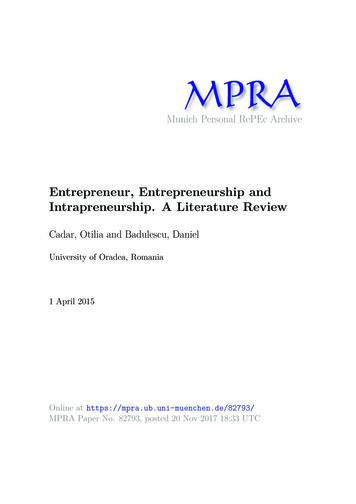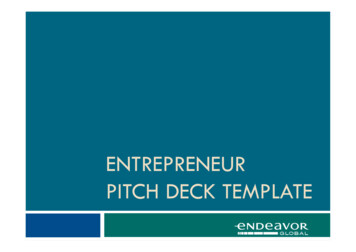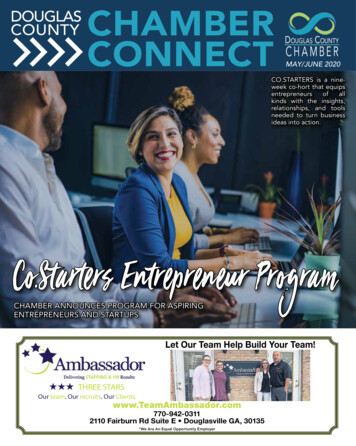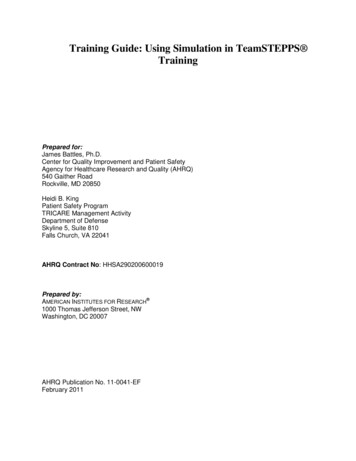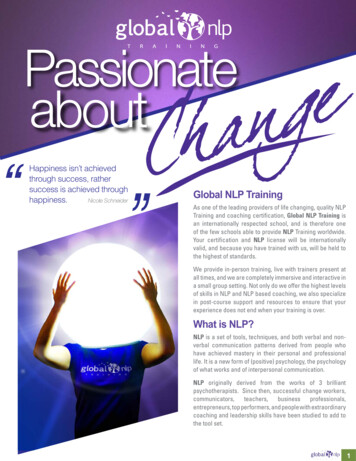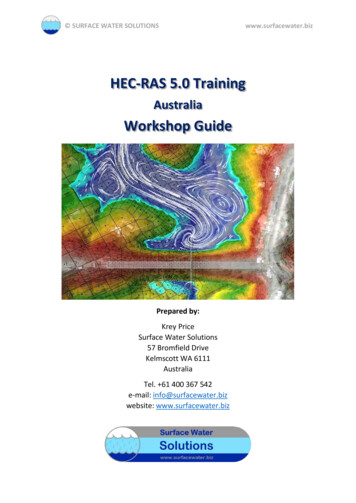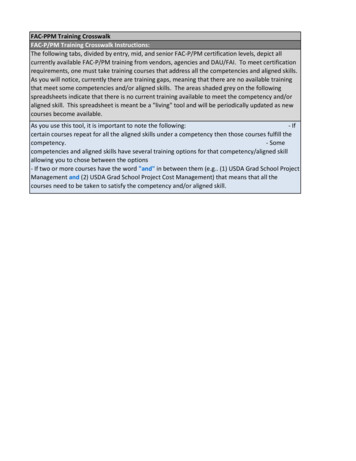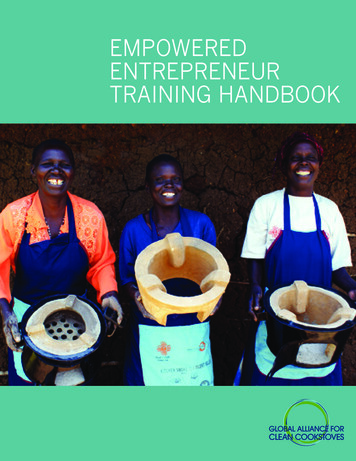
Transcription
EMPOWEREDENTREPRENEURTRAINING HANDBOOK
The Global Alliance for Clean Cookstoves isa public-private partnership hosted by theUnited Nations Foundation that seeks to savelives, improve livelihoods, empower women,and protect the environment by creating athriving global market for clean and efficienthousehold cooking solutions. The Alliance’s100 by ‘20 goal calls for 100 millionhouseholds to adopt cleaner and moreefficient cookstoves and fuels by 2020. TheAlliance is working with its public, privateand non-profit partners to help overcome themarket barriers that currently impede theproduction, deployment, and use of cleancookstoves and fuels in developing countries.COVER PHOTO CREDIT: PRACTICAL ACTIONBest practices and tools for engaging womenand addressing gender issues can be foundin the Alliance’s Resource Guide on ScalingAdoption of Clean Cooking Solutions throughWomen’s Empowerment.2
CREDIT: THE PARADIGM PROJECTEMPOWEREDENTREPRENEURTRAINING HANDBOOKCREDIT: SOLAR SISTERFunding for this handbook was generously supported byFinland’s Ministry for Foreign Affairs (MFA).The views presented in this paper are those of the authors and do not necessarilyrepresent the views of the Finnish MFA.2015CREDIT: MELINDA MARQUIS, THE VISIONARIA NETWORKUpdated April 2016
Genevieve Smith - Lead AuthorGenevieve Smith specializes in research and analysis of gender-relatedissues and opportunities within the household energy sector. Ms. Smithhas consulted for the Global Alliance for Clean Cookstoves within genderand markets for several years, and is the lead researcher and co-author ofScaling Adoption of Clean Cookstoves through Women’s Empowerment:A Resource Guide. She has experience working throughout variouscountries in Latin America and Asia. Ms. Smith is currently the director ofthe Visionaria Network, which specializes in leadership and agency-basedempowerment training, as well as building organizational capacities tosupport women and girls.Anita Shankar - Lead AuthorDr. Anita Shankar is a medical anthropologist with more than twenty yearsof experience in public health research and programs focused on women’sempowerment and maternal and child health. Her research spansnumerous countries worldwide where she has lived or worked includingNepal, India, Indonesia, Papua New Guinea and Kenya. Her currentresearch focuses on impacts of agency-based empowerment training ondisenfranchised women. She recently completed a study to assess thesignificance of engaging women along the clean cookstove value chainthat documents the impacts of an agency-based empowerment trainingon entrepreneurial capacity and cookstove adoption.
Business Training Development - GVEP InternationalGVEP (Global Village Energy Partnership) International works with localbusinesses in developing countries to increase access to modern energyand to improve the quality of lives for millions of people. GVEP firmlybelieves that businesses offer the best solutions in many cases, and aimsto provide high quality, professional services to support the growth of theprivate sector.ContributorsCindy Cordova Consultant, the Visionaria NetworkCorinne Hart Director of Gender and Humanitarian Programs, GlobalAlliance for Clean CookstovesPaola Saldivias ConsultantPaul Spurzem Consultant, the Visionaria NetworkRachel Mahmud Gender Associate, Global Alliance for Clean CookstovesAcknowledgmentsThe Empowered Entrepreneur Training Handbook benefited from thecontributions of many individuals. Helpful edits were provided by RadhaMuthiah, Leslie Cordes, Jen Tweddell, and Stephanie Valdez from theGlobal Alliance for Clean Cookstoves. Valuable inputs were provided bythe following experts: Jade Gray (IDEO.org), Johanna Matocha (Evaluent),Jessica Alderman (Envirofit), Mary Alice Onyura (ESVAK), Mabel Isolio(ENERGIA), and Svati Bhogle (ENERGIA). We would like to give specialthanks to GIZ Peru, Alicia Castro Rivera (GIZ Peru), and the VisionariaNetwork team.
TABLE OF CONTENTSINTRODUCTIONWho should use this Handbook and what is it?.iWhy was this Handbook developed? .iiiHow was the Handbook developed?.ixHow to use the Handbook?.xiLimitations of the Handbook.xiiCore Competency Roadmap.xiiiPART 1: HUMAN-CENTERED DESIGN (HCD) PLANThe accompanying HCD Workbook guides trainers through the process of preparing acustomized training approach using Human-Centered Design principles. Available for downloadat www.cleancookstoves.org.Introduction and Use.1Select HCD Exercises.4HEAR1. Who are your participants?2. Value proposition3. Explore core competencies4. Brainstorm teaching methods5. Develop your mindsetTeacher to guideUnderstanding the value of timeReviewing your ownassumptions and limitingbeliefsApplying a gender lensBe positive and rememberto laughCREATE1. Select your training activities2. Develop your trainingSelect your training timelineCommunity agreementsContext appropriateness3. Prepare your training techniquesStory timeBrainstorming opportunities4. Envision “Success”Brainstorm: What does“Success” look like?Prepare for feedbackFoster accountabilityDELIVER1. Best processes for implementation2. Brainstorm: Potential challengesand solutions3. Develop your monitoring approachTool: Training surveysTool: Evaluate yourself4. Creating a support systemMentorsPeer support groups or peerbuddiesMeeting spaces and continualgrowth
PART 2: EMPOWERED ENTREPRENEUR TRAINING ACTIVITIESIntroduction & Gender ExercisesWarm-up/Introduction Exercises.16Entrepreneurship Core Competencies .18Sex & Gender.24Building The Skills - This Business section will delve into basic business and financiallesson plans and activities to implement with participantsIntroduction: My Business Model.32Topic 1: Marketing & Customer Care.33Topic 2: Costing & Pricing.49Topic 3: Financial Planning & Management.55Topic 4: Business Growth & Expansion.64Finding Your Voice – The Empowerment section will explore techniques and exercises tohelp individuals understand themselves and what is important to themIntroduction to Empowerment Section .78Topic 1: Building Trust in Ourselves.80Topic 2: Understanding Oneself.83Topic 3: Understanding Our Core Beliefs.91Topic 4: Identifying & Appreciating One’s Strengths.99Topic 5: Developing Positive Mental Habits.100Topic 6: Managing Fear & Risk.104Topic 7: Knowing Ourselves Through Our Bodies.107Moving It Forward – The Leadership section will provide tools and lesson plans fordeveloping leadership skills and enhancing leadership competencies amongparticipantsIntroduction to Leadership Section.112Topic 1: Introduction to Leadership.115Topic 2: Establishing & Developing Clear Visions.118Topic 3: Setting Goals & Being Proactive.126Topic 4: Problem Solving.132Topic 5: Communication.137Topic 6: Plan of Action.144Reflect: Monitoring and Post-Training SupportGlossary of Terms
WHO SHOULD USE THISHANDBOOK AND WHAT IS IT?VALUE CHAINThis Handbook is for organizationswho are currently working with, or planto work with, women entrepreneursto produce or support the design ofhousehold energy technologies, or whowill engage women as sales agentsor entrepreneurs in rural or urbanlocations to market, distribute, and/orprovide after-sales service of householdenergy technologies.DesignManufactureDistributionCREDIT: PRACTICAL ACTIONiSales Services
INTRODUCTIONThe Empowered Entrepreneur Training Handbook provides six days of business skills,empowerment, and leadership training curricula and tools that can be implementedto better support the women sales agents and entrepreneurs with whom youwork. Thoughtful planning and preparation by organizers is required in order tosuccessfully implement this training. Trainers and implementing organizationsshould complete a Human-Centered Design (HCD) Plan (Part 1 of this Handbook),which will help you prepare a successful, customized training using the materials.Before completing the HCD Plan, it is necessary to read and become familiar withthe Handbook lesson plans and content.The Empowered Entrepreneur Training Handbook is designed to support anorganization and its trainers in empowering women micro-entrepreneurs, smallenterprise owners, and sales agents who work throughout the value chain in thehousehold energy sector. While the Handbook has been developed by the Allianceand is designed to empower women to scale adoption of clean cooking solutionsglobally, it has applicability throughout the household energy sector.While women are well-positioned for entrepreneurship/sales, we would liketo note that they are also good as managers, scientists, engineers, etc. ThisHandbook is focusing on training women as entrepreneurs or sales agents, butthere is potential for them to engage in many other ways in the cooking sector.An entrepreneur, for the purposes of this Handbook, can be loosely definedas a person seeking to increase his/her income through his/her own businessactivities.A micro-entrepreneur has no employees and operates alone. Microentrepreneurs often fill the gap between a larger business and remotecustomers.A small-sized enterprise owner can do the same, but employs one to five othersin conducting business. Both micro-entrepreneurs and small-sized enterpriseowners add value by providing services the business cannot do alone.A sales agent sells a specific product(s) for a business at a designated price,and potentially receives commission for sales, as well as a base or full salary.The Handbook uses the term entrepreneur generally, in reference to bothmicro-entrepreneurs and small-sized enterprise owners, as well as sales agents.ii
iii
WHY WAS THIS HANDBOOKDEVELOPED?THE ALLIANCE IS COMMITTED TO supporting its partners in reaching the goal of 100 millionhouseholds adopting clean and efficient cookstoves and fuels by 2020. The Alliance and its partnersrecognize the contributions that women make in achieving the sector’s health, environment, women’sempowerment, and livelihood goals. Without engaging women throughout the value chain, it is likelythat global efforts will be less effective and scale less rapidly.This Handbook is one component of the Alliance’s overall gender and empowerment strategy to betterleverage women’s ability to impact adoption rates of clean cooking solutions. This overarching strategyis built around five major pillars with activities that will strengthen gender impacts and scale adoptionthrough gender-informed approaches.In September 2013 the Alliance released Scaling Adoption of CleanCooking Solutions through Women’s Empowerment: A Resource Guide.This Resource Guide is a tool for a wide variety of sector stakeholders toincrease their understanding of why women are critical to the adoptionand sustained use of clean cookstoves and fuels and how to ensure theyare included in every segment of the value chain. This Handbook buildsoff one of the core, universal best practices in the Resource Guide—toprovide initial and ongoing training (including empowerment, leadership,and business and technical skills) to women in the value chain.Five Pillars of theAlliance’s Gender andEmpowerment StrategyI. Build the evidence andevaluate approachesII. Build capacity of sectorstakeholdersIII. Increase access tofinanceIV. Raise awarenessV. Set and influence policiesivCREDIT: CHRISTOPHER CARRUTH, THE VISIONARIA NETWORK
INTRODUCTIONWhy does this Handbook have a focus on women microentrepreneurs, small-sized enterprise owners and sales agents?Women play critical roles in scaling adoption of clean cookstoves and fuels becauseof their central responsibility for cooking and managing household energy. Inaddition to deciding whether to use clean cooking products, women can catalyzethe market as micro-entrepreneurs and small-sized enterprise owners through thedistribution and delivery of clean cooking technologies and after-sales servicesthat will contribute to the creation of a thriving global market. Since men do notcommonly cook as much as women in the household, women’s experience can helpthem conduct point-of-sale activities. In addition, women can leverage their existingnetworks to promote the adoption of these new technologies and use their firsthandexperiences in marketing solutions. In areas where there are high levels of genderinequality, female sales agents can directly reach women who cannot readily accesscities or markets.1*Why conduct training related to agency-based empowerment andleadership?Training that integrates agency-based empowerment concepts and leadershipstrategies has immense opportunity to strengthen the capacity and effectivenessof women entrepreneurs. Agency-based empowerment enhances an individual’scognitive capacity to create and focus on his/her goals, and leadership skillsenable the tangible realization of these goals. Gender and empowerment researchcommissioned by the Alliance has demonstrated the need to foster agency-basedempowerment and leadership as key components in effectively engaging womenentrepreneurs in the clean cooking value chain.This Handbook is meant to support partners who work with women in the cleancooking value chain and can be a starting point for fostering women’s empowermentand supporting existing women entrepreneurs. However, it does not include adviceor strategies for recruitment of women. It is a tool to enable organizations alreadyworking with women to enhance the effectiveness of the entrepreneurs and agentsworking throughout the value chain.Did you know? Evidence suggests that the most common energy enterprises ledby women worldwide are in producing and distributing cookstoves.2, 3v1* Brush, C.; Greene, P., Kelley, D., Litovsky, Y. (2011). GEM 2010 women’s report: Women entrepreneurship worldwide. Global Entrepreneurship Monitor.2 Bhogle, S. (2003). Rural women as agents of improved woodstove dissemination: A case-study in Huluvangala Village, Karnataka,India. Energy for Sustainable Development VII (3): 70-75.3 Njenga, B. (2001). Generating opportunities: case studies on energy and women. Upesi rural stoves project. United Nations Development Programme.
WHAT DOES EMPOWERMENT AND AGENCYMEAN?While there are many definitions of empowerment, the Alliance defines empowerment as the abilityof individuals to create and act upon decisions that affect their lives. The notion of empowermentis fundamentally comprised of two complementary and critical components—resources andagency. Resources include extrinsic supports such as new skills, availability opportunities, financialresources, and/or education. Agency refers to psychological states (on an individual level) and isstrongly tied to self-esteem, sense of control, and power or self-reliance. Agency is the capacity,condition, or state of acting or of exerting power that is focused on their ability to formulatestrategic choices and to control resources and decisions that affect important life outcomes. In thecase of women entrepreneurs:1. Women need resources to support their growth and take advantage of opportunities in orderto succeed and advance personally and economically.2. Women need to have the agency to make and act on decisions, including being able tocontrol resources and profits.Together, resources and agency constitute capability, which is the potential that people have forliving the lives they want and achieving valued ways of “being and doing”.4**4 Sen, A (1985) Commodities and Capabilities. Amsterdam & New York: North Holland.CREDIT: NANCY HUGHES, STOVE TEAM INTERNATIONALvi
INTRODUCTIONRecent research findings on impacts ofagency-based empowerment trainingon health, development and well-beingvii Urban and rural disenfranchised women in Kenya – Research foundthat after four months, those undergoing agency-based empowermenttraining were three times more likely to report improvements ineconomic condition, ten times more likely to report improvements inhealth and 15 times more likely to report improvements in relationships. Women living in Mathare slums in Kenya – After receiving training,women created two savings groups. After 6 months, 90% of the womenreported having a better capacity to pay for rent, cover educationalexpenses and save. HIV positive pregnant and lactating women in India – After receivingtraining, women were found to have enhanced adherence to antiretrovirals (ARV) and improved health seeking behaviors. Women engaged in sex work in India – Research has documentedthat those who have undergone training, have substantial increasesin adherence to ARV and increased testing for HIV, tuberculosis, anddiabetes. In addition, 80% started savings accounts and after one yearnearly 25% of the women independently had the capacity to seek otheremployment and leave sex work.CREDIT: RANYEE CHIANG
Evidence Demonstrates that Agencybased Empowerment Training Can IncreaseSales and Customer SatisfactionThe Alliance commissioned three research studies (Kenya, Bolivia, Nigeria) to test this agencybased empowerment and leadership training to determine what kind of impact it can have onwomen entrepreneurs and sales and adoption of cooking solut
The Empowered Entrepreneur Training Handbook provides six days of business skills, empowerment, and leadership training curricula and tools that can be implemented to better support the women sales agents and entrepreneurs with whom you work. Thoughtful plann


